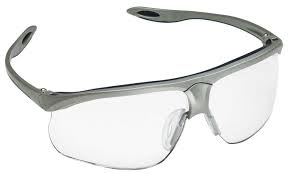4.2 Personal protection
A protective lab coat and safety goggles should be worn at all times in the laboratory.
For most laboratory work a cotton lab coat is required.
For work in clean rooms a polyester lab coat can be more suitable unless handling open flame, heat or chemicals reacting with the fabrics since polyester melts to your skin inflicting serious skin burns.



Personal protective equipment should be used to protect against illness or accident. Protective Equipment is provided by the employer (read more at Work Environment Act - Sveriges riksdag).
Find out what protective and rescue equipment is available and where it is located at your department/division. The division head is responsible for the work environment, shall ensure that appropriate personal protective equipment is available in sufficient quantities and in good working condition.
Examples of personal protective equipment
- Protective/chemical resistant lab coat or apron
- Safety googles or face shield/visor
- Gloves
- Ear protection, includes earmuffs and earplugs
- Respiratory protection
- Protective shoes or boots
Note! Lab coats may not be worn in public areas such as offices, eating areas or lounge areas. A lab coat may transfer hazardous materials and contaminants into these areas and expose the general public.
In the laboratory
- Do not wear high-heeled shoes, open-toed shoes, sandals, or shoes with tops made of fabric, leather strips or other woven material.
- Do not wear shorts, cutoffs or miniskirts.
Lab Glove Policy
Gloves or no gloves?
- Use an UNGLOVED hand to touch common surfaces, and a GLOVED hand if you touch hazardous materials inside the laboratory.
- Gloves should never touch door handles, elevator buttons, telephones, lavatory faucets, or other common surfaces.
When necessary, correct protective gloves should be worn. Gloves are made from variety of materials, no one of which is impervious to every chemical. Examine the manufacturers´claims and test data carefully, use the gloves only under conditions for which they are intended as protection against, the penetration of the chemical for which they have been designed.
Remember that given enough time, any glove will be permeated by chemical to which it is "impermeable" for. This can happen without any visible effect on the material and without being felt. A glove material that gives good protection against one chemical may be ineffective against another. Once more check with the manufacturer or retailer or in the product information sheet to find out which gloves you should choose to use for the chemicals you are using.
Note! Protective gloves are not allowed outside the lab. Protective gloves may transfer hazardous materials and contaminants into these areas and expose the general public.
